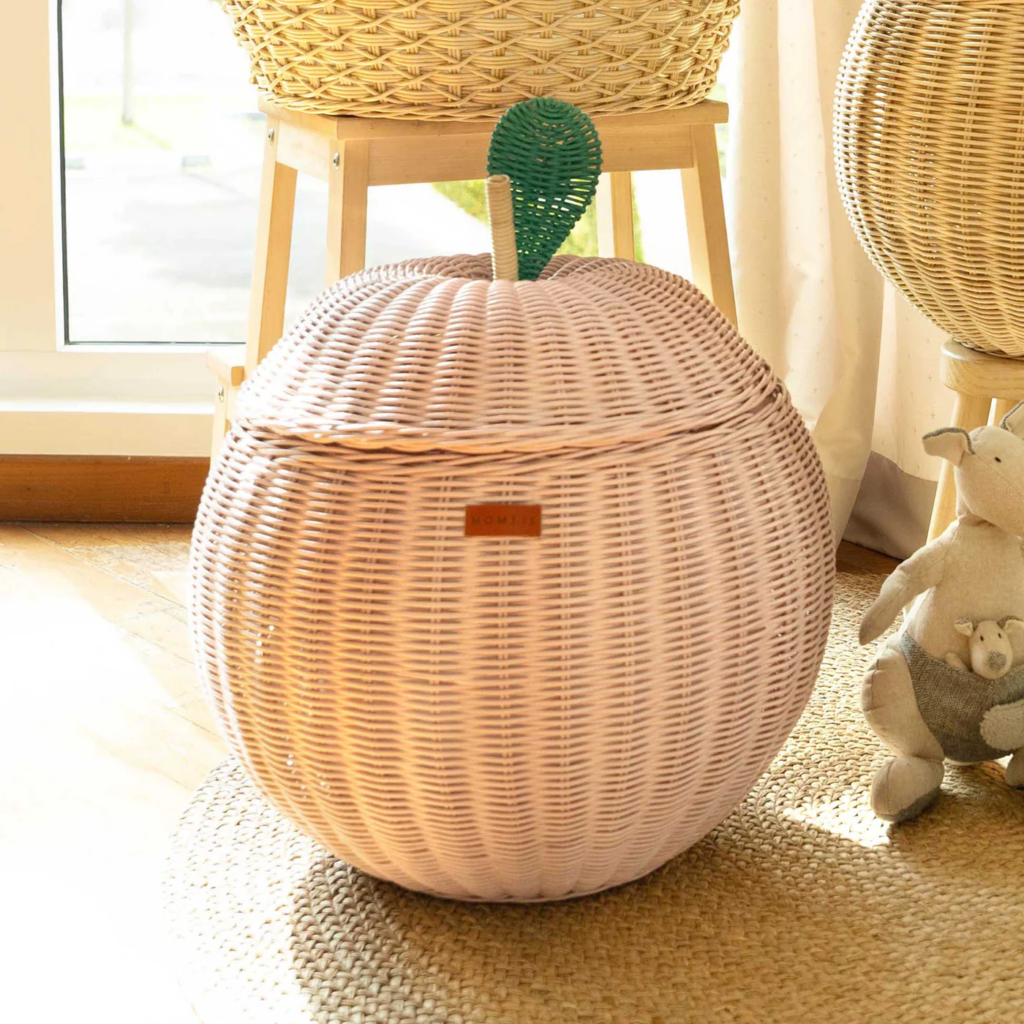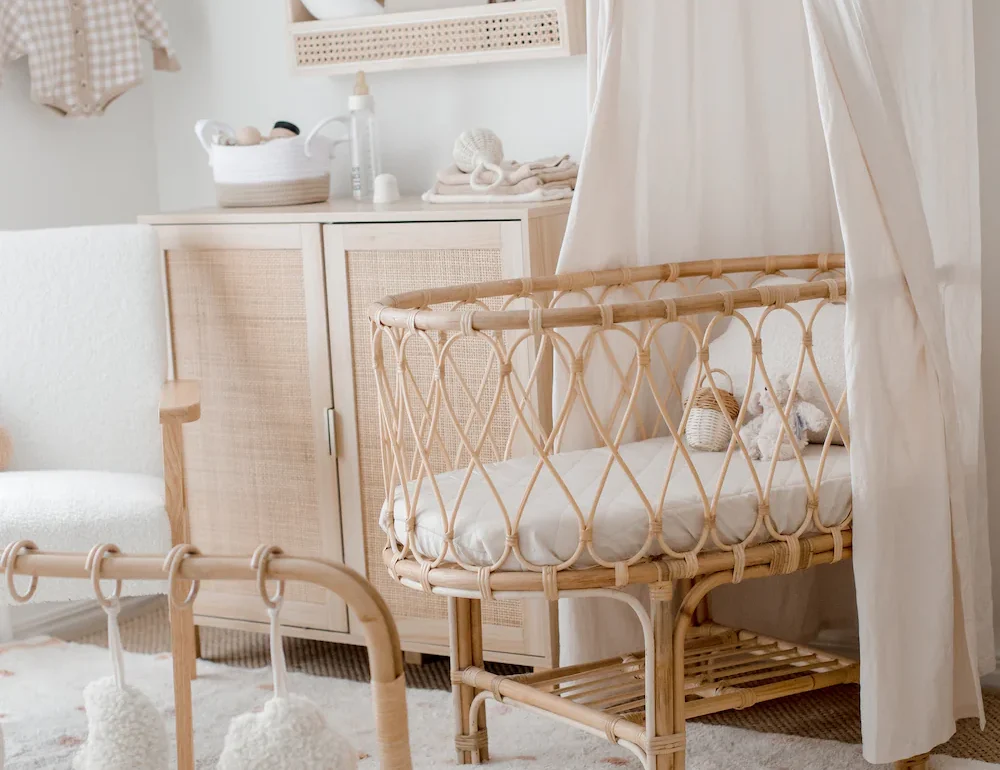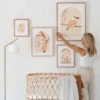Designing a nursery can feel like one of the most joyful parts of preparing for a baby. It’s the space where you’ll cuddle, feed, change, and rock your newborn to sleep, and naturally, you want it to feel magical. But between the dreamy Pinterest boards and the avalanche of cute decor options, it’s easy to lose sight of the things that actually matter most: safety, function, and flexibility.
And here’s the thing, many nursery decorating mistakes aren’t obvious until you’re deep in the midnight diaper changes or trying to baby-proof on the fly. That’s why we’re pulling back the curtain and sharing the most common nursery design missteps—and what to do instead—so you can create a space that’s as smart as it is beautiful.
1. Forgetting That Safety Comes First
It’s tempting to jump straight to aesthetics, but safety is the foundation of any good nursery. That tufted artwork above the crib? Looks cute—but could fall. The gorgeous dresser with sharp metal handles? Not great once your baby starts to stand. Nurseries should always start with safety, and that means anchoring furniture to the wall, avoiding heavy objects over the crib or changing table, and checking that every corner, edge, and surface is baby-friendly. If a baby can pull it, chew it, or climb it, it needs to be secure, soft, or out of reach. Every design choice should support peace of mind—because function never goes out of style.
2. Choosing Materials That Aren’t Baby-Safe

Not all furniture and paint are created equal, especially when it comes to a newborn’s sensitive system. That stylish crib set you found online? It might be made from pressed wood or finishes that emit VOCs—volatile organic compounds linked to respiratory issues and skin sensitivities. The same goes for rugs, glues, and even some wall decals. As beautiful as they may look, off-gassing chemicals have no place in a baby’s room. Instead, go for paints labeled zero-VOC, solid wood and rattan furniture with water-based finishes, and textiles certified organic when possible. Not only will the space look great, it will feel fresher and safer for everyone.
3. Overlooking Electrical Safety
One of the most common oversights in nursery design is forgetting about all the cords and outlets hiding in plain sight. Floor lamps, baby monitors, white noise machines, and humidifiers quickly multiply, and if their cords aren’t managed, they become potential hazards. Dangling wires pose strangulation risks, especially once your baby starts crawling or pulling up on furniture. It’s important to plan ahead by using outlet covers, concealing cords behind furniture, and choosing cordless blinds to eliminate looping strings. Design-wise, the space should feel serene—but behind the scenes, it needs to be engineered for safety from day one.
4. Picking Pretty Over Practical
We all love a nursery that’s visually stunning, but looks alone won’t carry you through sleepless nights. A sleek rocking chair might match your mood board, but if it’s uncomfortable or hard to clean, you’ll end up avoiding it. The same goes for changing tables with little storage or cribs that don’t convert. Everything in the nursery should earn its spot. Ask yourself: will this make my day-to-day easier? Can I clean it easily? Will it hold up over time? Good nursery design finds the sweet spot between function and beauty. The best pieces do both.
5. Committing Too Hard to a Theme
It’s fun to imagine a safari or fairytale-themed nursery, but committing to a theme too literally can paint you into a corner—both stylistically and financially. Babies grow fast, and their needs (and your taste) will change even faster. That zebra print wallpaper or character bedding might lose its charm after a few months. Instead of building the entire room around a single concept, try keeping the major elements timeless—like the furniture and wall colours—and bringing in themed accessories like cushions, art prints, or mobiles. That way, when you’re ready for a refresh, you won’t have to start from scratch.
6. Choosing Colours That Don’t Age Well
Bold colour choices can be tempting when you want to make the nursery feel playful or gender-specific, but overly bright or saturated hues often don’t age gracefully—and some can even overstimulate babies. Bright reds, electric blues, or super dark tones might seem fun, but they can interfere with sleep or make the room feel smaller and more chaotic. Instead, soft, muted tones like sage, peach, dove grey, or oatmeal tend to create a calming environment that transitions well as your baby becomes a toddler. Colourful accents can still come into play—just make sure the base palette feels soothing and flexible.
7. Creating Clutter With Open Shelving

Open shelves are stylish and Insta-worthy, but they often end up becoming dust collectors—or worse, clutter magnets. When you’re juggling diaper changes, bottles, and baby laundry, having to neatly style every single surface becomes exhausting. Not to mention, open shelves placed too low can become grab zones once your baby is mobile. Closed storage solutions like baskets, bins, or drawers help keep the space tidy and visually calm. If you do want to display a few favourite books or toys, limit it to one or two shelves and rotate items regularly to keep it manageable.
8. Decorating With Unsafe Accessories
It’s easy to get carried away with tiny details—think pom-pom garlands, beaded decor, or vintage finds—but not all accessories are safe for a baby’s environment. Small parts can come loose, string accents pose strangulation risks, and some cute second-hand items may have been made with outdated safety standards. If something could be pulled off and popped into a mouth, it’s better to skip it. Focus instead on soft textiles, secure wall decor, and heirloom-quality items designed specifically for nurseries. You can still get that “curated” look—just make sure it doesn’t come at the cost of safety.
9. Using Artificial Scents That Overpower
We all love a space that smells good, but artificial air fresheners, plug-ins, or scented candles can actually cause more harm than good—especially for newborns with developing lungs. Babies are sensitive to strong scents, and many synthetic fragrances contain phthalates and other chemicals that can linger in the air. Instead of masking odours, improve ventilation, open windows when possible, and opt for natural alternatives like essential oil diffusers (used sparingly), fresh eucalyptus, or scent-free cleaners. A nursery should smell clean and light—not like a department store perfume aisle.
10. Making Lighting Too Complex (or Not Bright Enough)
Lighting might not be the first thing you think about when decorating a nursery, but it plays a major role in both functionality and mood. A single overhead light might feel harsh in the middle of the night, while too many fussy fixtures can become overwhelming to manage. Ideally, your lighting should be layered and adjustable. A soft bedside lamp or wall sconce for late-night feeds, blackout curtains for naptime, and a dimmable overhead option for flexibility will make the space far more usable. Aim for lighting that can adapt with your needs—and that won’t blind you at 3am.
11. Designing a Room That’s “Too Perfect”
It’s easy to get caught up in wanting your nursery to look picture-perfect. But sometimes, in the effort to make it all look beautiful, we forget that this is a space for real life—a space where things get messy, loud, and emotional. A nursery that’s too precious can actually feel stressful to use. Don’t be afraid to design for comfort. Use that extra blanket. Get the wipe-clean fabric. Skip the pristine white chair if you’re nervous about spills. Choose items that make you feel relaxed, not like you’re stepping into a museum.
12. Not Thinking Ahead As Your Baby Grows
The biggest mistake of all? Designing only for the newborn stage. Your tiny baby will become a crawling, climbing, curious toddler faster than you think. Choosing nursery furniture and layouts that can evolve with your child—like convertible cribs, changing tables that double as dressers, or neutral colour schemes—is one of the smartest investments you can make. You’ll save yourself the trouble of a redesign in just a year or two, and your space will grow with your child instead of feeling like it belongs to a different season of life.
Creating a nursery is one of the most personal parts of preparing for a baby. It’s where first memories are made, sleepy cuddles happen, and so many milestones unfold. When you design with safety, function, and longevity in mind, you give yourself the freedom to actually enjoy those moments instead of fighting with the furniture or regretting the rug. So go ahead—make it beautiful. Just make sure it works for real life, too.


